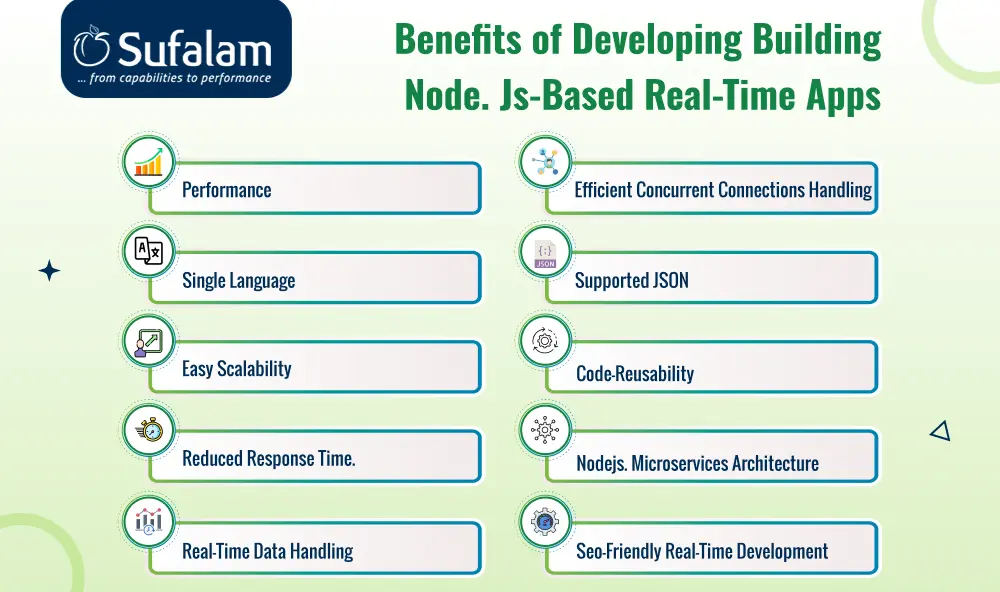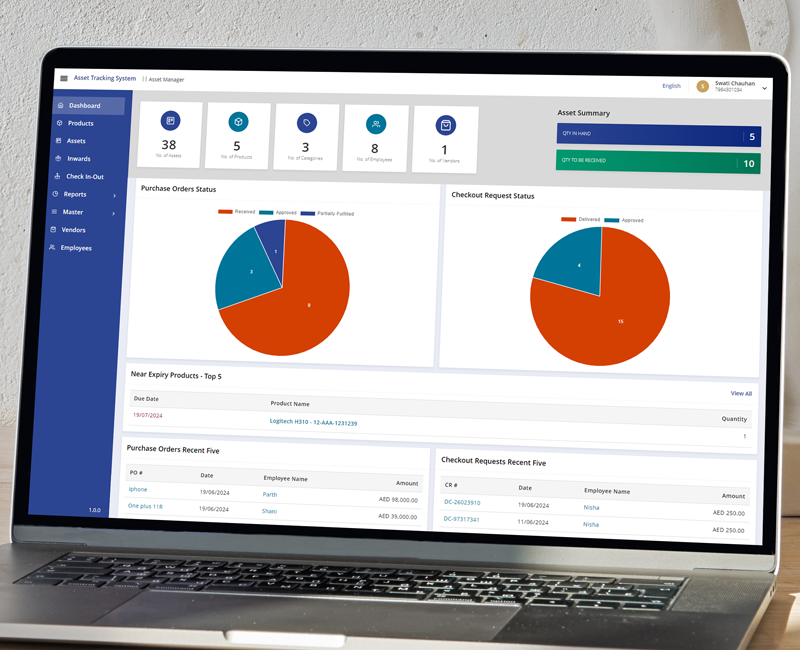
In today's fast-paced digital world, the demand for real-time applications is skyrocketing. Whether it's live chat, online gaming, or collaborative tools, users expect instant responses and seamless experiences.
Well, to develop the best-in-class real-time applications - Nodejs is your best bet and it is proving to be the game-changer in the world of web development.
According to a 2023 survey by Stack Overflow, Node.js remains one of the most popular technologies among developers, with over 47% of them choosing it for its efficiency and scalability.
But what makes Node.js the go-to choice for building real-time applications? Well, there are not one or two - but many reasons to choose Nodejs for real-time app development.
From its robust ecosystem of libraries and frameworks to its ability to manage high traffic with minimal resource consumption, Node.js offers everything you need to build responsive, efficient, and scalable real-time applications. So, let's explore how you can harness the power of Node.js development services to meet the demands of today's dynamic user expectations with best-in-class real-time applications.
What is Nodejs?
Node.js is an open-source, cross-platform JavaScript runtime environment that allows you to execute JavaScript code outside of a web browser. Powered by the V8 JavaScript engine used by Google Chrome, Node.js translates JavaScript code into a readable format for efficient execution.
According to Statista, Node.js is ranked first among prominent web frameworks.
One of the standout features of Node.js is its ability to use JavaScript on both the front end and the back end, middleware, and beyond. The Node Package Manager (npm) offers a vast library of over 350,000 packages, simplifying the process of bootstrapping projects with pre-built functionality.
It is particularly popular for building back-end applications and handling data-intensive tasks, especially real-time applications with Nodejs because of its event-driven, single-threaded I/O model that handles asynchronous tasks using promises or async/await features.
What are Real-Time Apps?
A real-time app allows users to receive and engage with information in real time, with no delays or lags. It improves the user experience by providing timely and correct information or communication, hence improving effectiveness and ex, ultimately.
What happens when you use an online application to communicate with friends, make a video call to someone who lives far away, or play an online game?
All of these scenarios have one thing in common: you are utilizing the service or communicating in real-time. The application processes input and responds in real-time, so it can function immediately.
It could be a real-time web or mobile application. Some of the most well-known examples of real-time apps are instant messaging, online gaming, and video conferencing programs like Instagram, Facebook, Gmail, Zoom, etc.
Is Nodejs Architecture Suitable for Building Real-time Application Development?
Node.js has a sophisticated architecture that is quite adaptable and scalable. The architecture is capable of handling enormous workloads along with high failure-tolerant capacity.
Node.js real-time app development handles several concurrent clients using a single-threaded event loop model architecture. As a result of its event-driven and asynchronous design, Node.js has emerged as one of the top programming languages for creating modern apps.
However, to manage numerous concurrent clients, technologies such as JSP, Spring MVC, ASP.NET, HTML, AJAX, and JQuery need a multithreaded request-response architecture.
Case Study: Uber Chose Node.js to develop a massive matching system!
Uber is a taxi-booking app having its operations across the world and is among the best examples of a real-time app, leveraging Nodejs. They chose Node.js to develop a massive matching system because of its better data processing capabilities and ability to connect with its business goals. With the growing demand for on-demand taxi services, Uber needs to invest in a dependable infrastructure for both its passengers and drivers.
When it comes to processing massive volumes of data rapidly and reliably, deploying code swiftly, and keeping up with ever-evolving technological advancements, Node.js works wonderfully. At the moment, Uber can handle more than 2 million remote processes.
10 Reasons to Choose Node.js for Building Real-Time Apps!

Performance
One significant benefit of building real-time applications is high Nodejs performance, which is possible through its non-blocking, event-driven architecture. Node.js uses the V8 JavaScript engine to compile JavaScript directly into machine code which leads to fast execution.
Its single-threaded event loop can handle thousands of simultaneous connections without the overhead of managing multiple threads. This design allows Node.js to process I/O operations asynchronously, minimizing latency and maximizing throughput.
As a result, building Node. js-based real-time apps can deliver rapid, responsive user experiences, even under high loads, making it an ideal choice for performance-critical applications.
Single Language
Typically, you need to use different types of frontend and backend technologies for real-time application development. However, NodeJS relies on the JavaScript programming language, which is a versatile language that can be used on both the front end and back end.
As a result, you need to use only one language for both - front-end and back-end to facilitate smooth data transfer between the client and the server. It offers the best possible synchronization between the server and the client. These incredible technologies also make development easier because when you hire Nodejs developers, they will just need to use one programming language.
Easy scalability
The workload is the primary reason for building Node. js-based real-time apps, as this technology improves system availability and fault tolerance.
Leveraging Node.js for real-time app development is one of the finest solutions because it operates on the V8 engine and is fast in terms of computing speed, allowing for easy management of rising traffic.
Developers can simply scale their apps both vertically and horizontally. Real-time applications with Nodejs can be scaled horizontally by adding extra nodes. Developers can consolidate additional resources into a single node to achieve vertical scaling.
Reduced response time.
Node.js has a single-threaded event loop approach, which allows it to handle more concurrent user requests without producing more threads and using fewer resources.
PayPal, a popular app, has seen numerous benefits from using Node.js to reduce response time. The company's primary purpose was to reduce server response times, as slow response times could harm the business. There was a noticeable improvement as the sites loaded 200 ms faster as a result.
Real-time Data Handling
Real-time applications need to process and transmit data with minimal latency, and Node.js excels with this.
Firstly, Node.js supports WebSockets which support in bidirectional communication between the client and server. This is quite crucial for real-time applications such as chat apps, live updates, and online gaming, where the server and client need to communicate instantly.
On top of it, Node.js provides built-in event emitters through which developers can process and manage real-time events efficiently. This is particularly useful for applications like live sports updates, stock market tickers, and collaborative tools where real-time data streams are needed.
Efficient Concurrent Connections Handling
Nodejs with its concurrent connecting handling feature is quite helpful for real-time apps because it often requires handling many connections simultaneously.
Node.js’s asynchronous nature allows it to handle thousands of concurrent connections with high throughput. This makes it ideal for applications like real-time collaboration tools, multiplayer games, and live streaming platforms.
And, with the Nodejs load balancing feature, it can be easily clustered to handle load balancing, distributing incoming connections across multiple processes to maximize resource utilization and ensure high availability.
Supported JSON
JSON facilitates data communication between the server and the client in real-time applications. Thus, it plays a significant role in the development of real-time apps. Other server technologies, such as Ruby on Rails and PHP, can handle JSON for communication, but only as binary models. Node JS can achieve this without the need for a conversion using JavaScript. As a result, it facilitates seamless data interchange in these applications.
Code-Reusability
Code reusability is very useful, whether you are creating mobile applications or real-time online applications. This is one of the primary reasons why developers use Node.js.
Sure, you can utilize Bit to build React modules that you can use in other projects. Moreover, NPM may be used to obtain and manage packages for many projects. When developers switch to Node JS from their current environment, it is more advantageous.
Nodejs. Microservices Architecture
Node.js supports the development of microservices, which is particularly beneficial for real-time applications due to its modularity and flexibility.
By breaking down a large, monolithic application into smaller, manageable services, Nodejs microservices architecture can ensure each service's independent development, deployment, and scaling. This modularity allows teams to work on different parts of the application simultaneously, speeding up development along with fault isolation so that failures in one service do not affect the entire development.
Additionally, with the flexibility of microservices architecture, companies can ensure different technologies and programming languages within different services, optimizing performance for specific tasks while maintaining overall system integrity - all of which makes it ideal for the complex demands of real-time applications.
SEO-friendly Real-time Development
Real-time single-page applications (SPAs) can be difficult to optimize for SEO owing to dynamic content rendering. Nevertheless, server-side rendering (SSR) frameworks such as Next.js provide solutions through Node.js development services, allowing the server to generate the first HTML content before client-side rendering.
This improves SEO by making sure search engines recognize fully rendered HTML, which increases visibility and ranks for real-time apps—which are essential for websites like community forums and news sites.
To Conclude
In conclusion, Nodejs offers numerous advantages that make it an excellent choice for modern web development followed by a robust environment and extensive functionalities to develop stunning real-time applications.
By leveraging building Node. js-based real-time apps, you can create responsive, efficient, and scalable solutions that meet the demands of today’s users and adapt to the evolving landscape of web technologies.
If you are looking for Node.js real-time app development services or would like to know whether Nodejs is the right fit for your real-time application development needs, then Sufalam Technologies can help you out. Our Nodejs development company understands your needs and follows the best practices to ensure the best results.
By adopting Node.js for your real-time applications and with Sufalam Technologies by your side, you can create responsive, efficient, and scalable solutions.
So, what are you waiting for? Book a Free Consultation call now & let’s get started!
Frequently Asked Questions
What libraries and frameworks are commonly used for Node.js real-time app development?
Popular libraries and frameworks include Socket.io for real-time, bidirectional communication, Express.js for building web applications and APIs, and Koa.js for a more lightweight and flexible framework.
What are the security considerations for Nodejs real-time app development?
Security considerations include protecting against common web vulnerabilities such as cross-site scripting (XSS), cross-site request forgery (CSRF), and SQL injection. Using secure communication protocols (e.g., HTTPS), regularly updating dependencies, and implementing proper authentication is also crucial for maintaining security in real-time application development.















